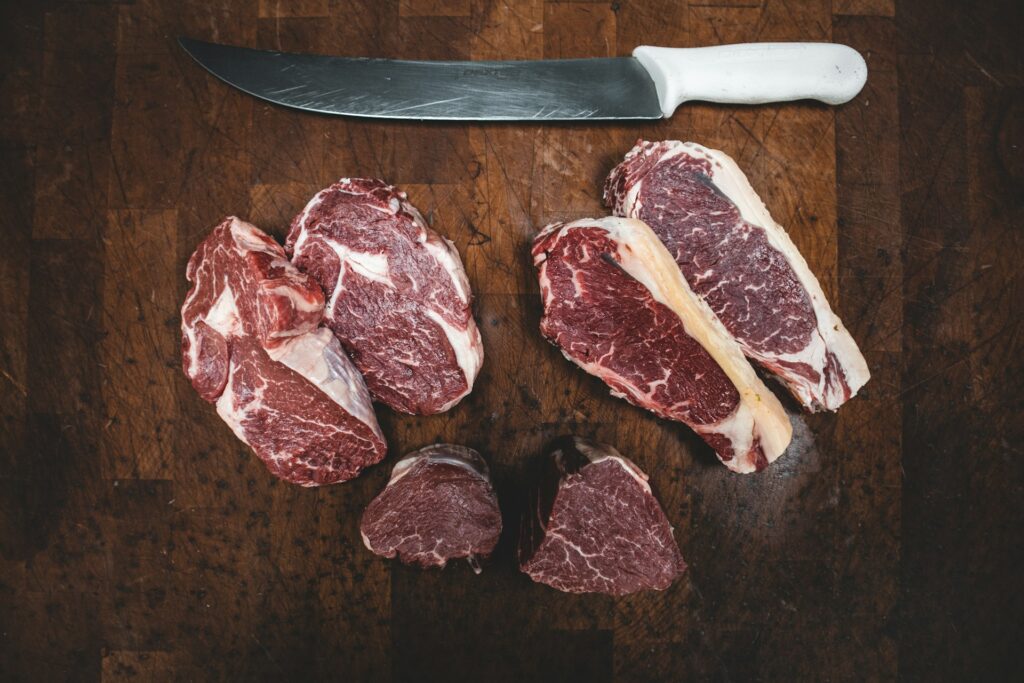
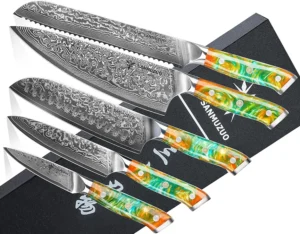

Cutting large chunks of meat requires the right tool. A butcher knife makes this task easier and safer. These knives have heavy blades and strong handles to handle tough cuts of beef, pork, and other meat.
We tested many butcher knives to find the ones that handle big cuts of meat with ease. Our top picks deliver sharp blades, comfortable grips, and the power needed to slice through thick steaks and roasts. This review also includes tips on meat cleavers when heavy chopping is required, and boning knives for fine trimming work.
The butcher’s knife differs from regular kitchen knives in several ways. The thicker, heavier blade can trim around bones, so you use less force. This makes cutting large roasts, whole chickens, and other big cuts much easier.
Top tips for choosing a butcher knife:
When choosing a butcher knife consider how often you will use the blade, and the type of meat that yuo will be cutting. This will help you choose the best blade within your budget:
| Price Level | Features |
|---|---|
| Budget ($20-50) | Basic steel, simple handle |
| Mid-range ($50-150) | Better steel, comfortable grip |
| Premium ($150+) | Top steel, perfect balance |

This knife works well for anyone who regularly breaks down large cuts of meat because it stays sharp and handles heavy butchering tasks with ease.
Pros
Cons
We used this knife for weeks to break down whole chickens, pork shoulders, and beef roasts. The curved blade shape helps keep meat from falling apart as you work. We often chose it over our other knives for large cuts.
The 8-inch blade length works well for most home butchering tasks. We easily separated ribs from a whole chicken and broke down a pork shoulder into smaller roasts. The lightweight design kept our hands comfortable during longer cutting sessions.
The blade flexes more than we expected, which helps follow natural meat lines but can feel wobbly when you need firm control. The Fibrox handle grips well when dry but gets slick with meat fat.
Sharpening was simple with a basic steel. We used this knife heavily for a month and only needed to touch up the edge twice. For the price, it held its sharpness better than other knives we’ve tested.

This knife suits anyone who needs a sharp, reliable tool for cutting large pieces of meat without spending much.
Pros
Cons
We tested this butcher knife on a large brisket. The blade sliced through the meat with almost no effort. The sharpness impressed us right out of the box.
The handle design works well for our grip. We didn’t experience any slipping even when our hands got greasy from the meat. The weight feels balanced and gives us good control over each cut.
After several uses, the blade still cuts cleanly without tearing the meat fibers. We’ve used it on roasts, large steaks, and whole chickens. Each time, it performed better than our old knife set.

This knife fits serious meat cutting tasks due to its sharpness and design features that make butchering large cuts easier.
Pros
Cons
We tested this curved butcher knife on several large roasts and found it cuts through meat easily. The blade stays sharp even after processing multiple pounds of beef and pork. The measurement holes along the spine help us cut steaks to exact thickness.
The curved blade design helps when working around bones and joints. We could separate meat from bone and trim fat without the blade getting stuck. The 10.5-inch length gives us plenty of room to work with large cuts like briskets and whole chickens.
The wooden handle feels solid and comfortable during long cutting sessions. The grip stays secure even when our hands get wet from meat juices. The weight distribution helps control the knife without causing hand fatigue.
The knife comes extremely sharp, so we used extra caution during the first few uses. The Damascus pattern looks beautiful but shows fingerprints and water spots, so we wipe it down after each use.

This three-knife set delivers professional-grade cutting power that makes breaking down large cuts of meat feel effortless.
Pros
Cons
We tested this Cutluxe set on several briskets and large roasts. The 12-inch brisket knife glided through thick cuts without dragging or tearing. The weight distribution feels perfect in your hand.
The 10-inch breaking knife separated ribs and cut through joints with ease. The curved blade design helps when working around bones and cartilage.
The 6-inch boning knife handled precision work well. We removed small bones and silver skin faster than with our old knives. The sharp tip lets you work in tight spaces without wasting meat.
After several BBQ sessions, these knives still sliced cleanly without dulling. The German steel construction shows its quality when cutting through different meat textures.

This knife set suits anyone who wants professional-grade butcher knives without high prices.
Pros
Cons
The weight of these knives immediately impressed us. The 8.5-inch meat cleaver cuts through bones and joints easily. The 9-inch breaking knife works well for separating large roasts and whole chickens.
The craftsmanship stands out in every detail. Each knife feels solid with no wobbling or flex. The wooden handles provide a secure grip even when our hands get messy during butchering tasks.
We tested all four knives on different cuts of meat over several weeks. The boning knife slides cleanly along bones and removes fat without tearing the meat. The Serbian chef knife works well for general prep work when we switch between tasks.
Maintenance requires attention but isn’t difficult. We wash them by hand and dry them immediately after each use. The anti-rust coating protects the blades between uses. These knives held their edge better than cheaper alternatives we’ve used before.

We recommend this knife set for home cooks and hunters who need a complete butcher kit at a reasonable price.
Pros
Cons
We tested this Bolexino set on various cuts of beef and pork. The curved boning knife separated meat from bone easily. The skinning knife handled fish and poultry cleanly.
The handles stayed comfortable during long cutting sessions. Even with wet hands, the knives never slipped.
The sharpening steel kept the blades working well between uses. We used it more often than with higher-end knives. The roll-up case makes storage and transport simple.
This set delivers solid performance for weekend hunters and home cooks. The German steel construction resists rust better than cheaper alternatives we’ve tried.

We recommend this knife set for anyone who needs sharp, reliable tools for breaking down large cuts of meat at home.
Pros
Cons
These knives arrived sharp straight from the box. The breaking knife sliced through thick steaks and roasts with minimal effort. Each blade felt balanced and sturdy during our testing.
The slip-resistant handles gave us a secure grip even when handling fatty cuts. The grip texture feels comfortable without being too aggressive on the skin.
With six different knives in one set, we always had the right tool. The curved boning knife followed bone contours, and the cimeter handled large cutting tasks easily. We switched between knives throughout the process, which sped up our work.
The stainless steel construction feels solid and durable. After several uses, the blades still look new with proper care. The full tang design gives each knife good balance and prevents flex during heavy cutting.
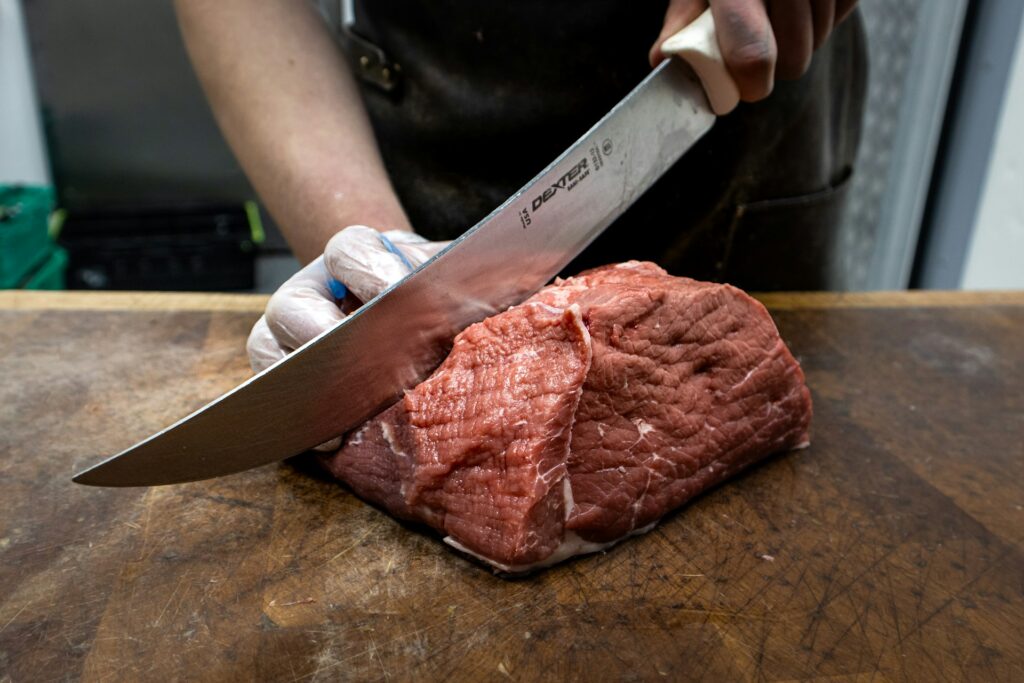
When cutting large chunks of meat its also handy to have a meat cleaver and a boning knife at your disposal. Each knife has its own job in the kitchen.
| Knife Type | Blade Length | Blade Breadth | Blade Flex | Typical Use |
|---|---|---|---|---|
| Boning Knife | 5–6.5 inches | Thin to medium | Flexible to semi-stiff | Removing bones, trimming meat |
| Butcher Knife | 6–14 inches | Medium to thick | Stiff | Cutting large pieces of meat |
| Meat Cleaver | 6–12 inches | Thick and heavy | Very stiff | Splitting bones, heavy chopping |
Butcher’s knives and meat cleavers are built for power. A butcher knife is best for slicing, trimming, and more precise cutting of meat.
You should use a meat cleaver instead of a butcher knife when you need to cut through very tough materials like bones, cartilage, or thicker cuts of meat.
The meat cleaver has a large, heavy, rectangular blade designed to deliver powerful chopping force. It’s ideal for:

This cleaver gives home cooks solid cutting power without the high cost of premium knives.
Pros
Cons
We used this cleaver to cut chicken bones and thick steaks. The blade stays sharp even after chopping through tough joints. The stainless steel construction cleans up easily with soap and water.
The handle feels solid without being too heavy. We grip it firmly even when our hands get wet. The balance point sits where it should for controlled chopping.
This cleaver works well for breaking down whole chickens and cutting ribs. We also used it for daily kitchen tasks like dicing vegetables. The 7-inch blade gives enough surface area for big jobs without being unwieldy.
The price makes it a smart choice for home kitchens. We get professional-level performance without high costs. The blade holds its edge well between sharpening.

This heavy-duty cleaver delivers solid cutting power for the price but has balance issues that affect handling.
Pros
Cons
We used this cleaver on chicken thighs and beef ribs. The blade cuts through bone easily thanks to its hefty 14-ounce weight. Out of the box, it sliced through frozen chicken with no problem.
The stainless steel construction holds up well to daily use. After months of regular chopping, the edge stays sharp with little maintenance. We like that it goes straight into the dishwasher without rust issues.
However, the balance feels off. The blade-heavy design makes our wrist tired faster than other cleavers. The handle doesn’t provide enough comfort for long butchering sessions.
For home cooks who need occasional heavy-duty cutting power, this cleaver gets the job done. The hanging hole is useful for storage, and the price makes it accessible for most budgets.
Boning knives give you the flexibility to work around bones and joints. Use a boning knife for tasks requiring precision and flexibility to separate meat from bones.

This knife works well for anyone who needs a sharp, affordable tool for working around bones and trimming meat.
Pros
Cons
We used this knife on several whole chickens and a large brisket. The curved blade easily followed the contours of bones. Breaking down chickens became much faster than with our old straight knife.
The Japanese steel holds a sharp edge. After processing multiple chickens, we restored the sharpness with just a few passes on a steel. The weight feels right—light enough to maneuver but substantial enough to handle tough connective tissue.
The blade’s stiffness limits delicate work around fish bones or poultry joints. The rigid construction works well for trimming fat and cutting through cartilage, but not for tasks needing blade flex.
The polypropylene handle provides a secure grip even when wet. We never felt like the knife would slip. However, the white material picks up stains from meat and fat, making it look used quickly.

This knife works well for detailed butchering tasks but requires sharpening before use.
Pros
Cons
We used this boning knife on several large cuts of meat and found it handles detailed work well. The curved blade slides around chicken joints and beef bones without much effort. The red handle stands out in our knife roll, making it easy to grab quickly.
The German steel blade came sharp enough for basic tasks but needed sharpening before tougher jobs. Once sharpened, the knife performed better on brisket trim and turkey breakdown. The flexible blade bends just enough to follow bone contours without snapping.
After several weeks, the edge didn’t hold as long as pricier knives. The handle also feels less sturdy than we want for commercial work. However, at this price, it delivers good performance for home cooks who need a reliable boning knife.
You may be wondering when to use a brisket knife. This blade is designed for slicing brisket and other large, cooked cuts of meat. It features a long, narrow, and flexible blade that allows for smooth, even slicing.
When to use a brisket knife:

This knife works for anyone who regularly cuts large roasts and wants professional results without a high price.
Pros
Cons
We used this 12-inch slicing knife on everything from smoked brisket to holiday turkey. The German steel blade cut through meat easily on our first use. After months of regular barbecue sessions, it still slices cleanly without tearing the meat fibers.
The full tang construction stands out when working with a heavy brisket. The knife never felt like it would snap or bend under pressure. The balance point sits where our fingers naturally grip, making long slicing sessions comfortable.
Storing this knife posed a challenge because most standard knife blocks can’t fit the 17-inch total length. We switched to a magnetic strip for our wall, which worked better.
The sharpness stood out during our testing. We sliced thin pieces of roast beef without any sawing motion. Even after cutting through crusty bread and dense meats, the edge stayed true. When sharpening was needed, the steel responded well to our honing rod.
These common questions cover the most important aspects of choosing and using butcher knives for large meat cuts. We address key features, maintenance, safety, and brand recommendations based on practical experience.
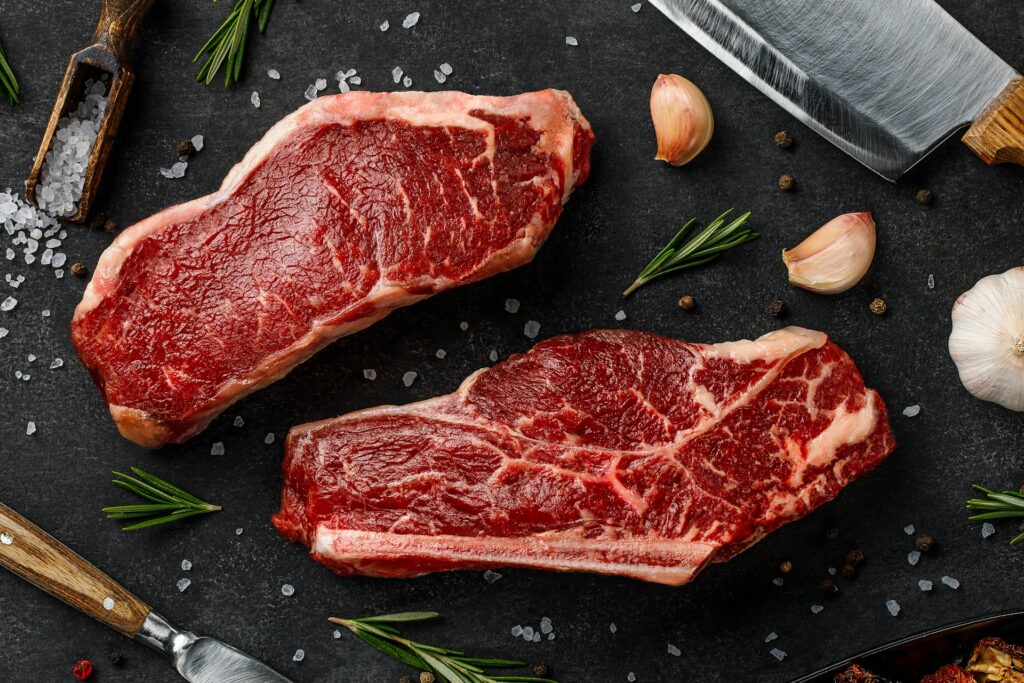
We recommend a blade length between 8 to 12 inches for large meat cuts. The blade should be heavy and thick to handle tough cuts without bending.
A full tang construction provides better balance and durability. The handle should offer a secure grip even when wet.
High-carbon stainless steel holds a sharp edge longer than regular steel. Look for knives with a blade width of at least 2 inches for stability.
We suggest the Wusthof Classic 3-piece butcher set for versatility. It includes an 8-inch butcher knife, 6-inch boning knife, and knife sharpener.
The Victorinox Fibrox Pro 3-piece set offers good value for home cooks. It features ergonomic handles and sharp blades at a lower price point.
For professional use, we recommend the Zwilling Pro 4-piece butcher set. It includes multiple blade sizes and comes with a storage block.
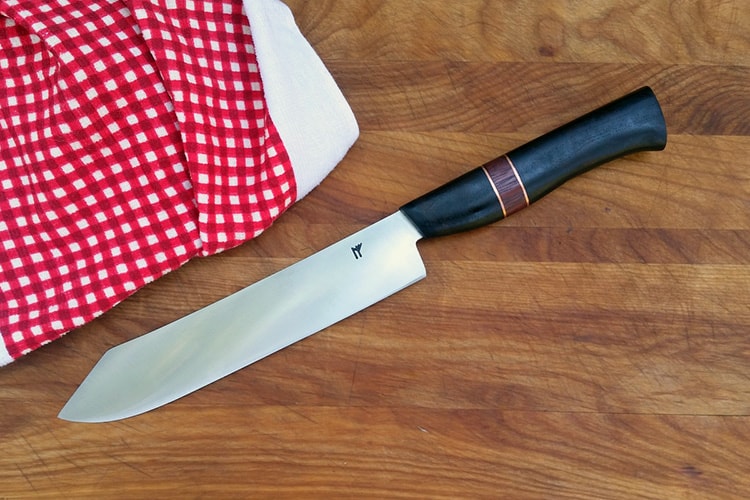
Wusthof makes some of the most durable professional butcher knives. Their blades hold edges well under heavy use.
Victorinox produces reliable meat knives with professional quality at reasonable prices.
Dexter-Russell is the oldest cutlery manufacturer in the United States. Dexter specializes in commercial kitchen knives.
Butcher knives have wide, heavy blades designed for chopping through bones and joints. They typically measure 8 to 12 inches long. Boning knives feature narrow, flexible blades for precision work around bones. They usually measure 5 to 7 inches long.
We use butcher knives for breaking down large cuts and chopping. Boning knives work better for removing meat from bones and trimming fat.

We recommend hand washing butcher knives immediately after use. Never put them in the dishwasher as it can damage the blade and handle. Dry knives completely before storing to prevent rust. Use a knife block or magnetic strip for safe storage.
Sharpen your knives regularly using a whetstone or professional service. A sharp knife is safer and more efficient than a dull one.
Always use a stable cutting board that won’t slip. Place a damp towel underneath for extra grip. Keep your fingers curled and away from the blade. Hold the meat securely with a claw grip while cutting.
Do not try to catch a falling knife. Step back and let it fall to the ground.
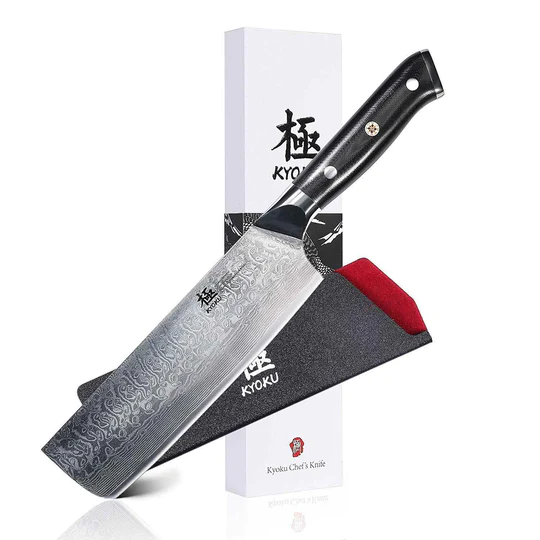
Knife Buzz offers independent product reviews on a wide range of knives used in the kitchen, home, and outdoors. We make it easy for you to find the right knife at the best price.